1987 MAZDA 626 wheel
[x] Cancel search: wheelPage 1392 of 1865
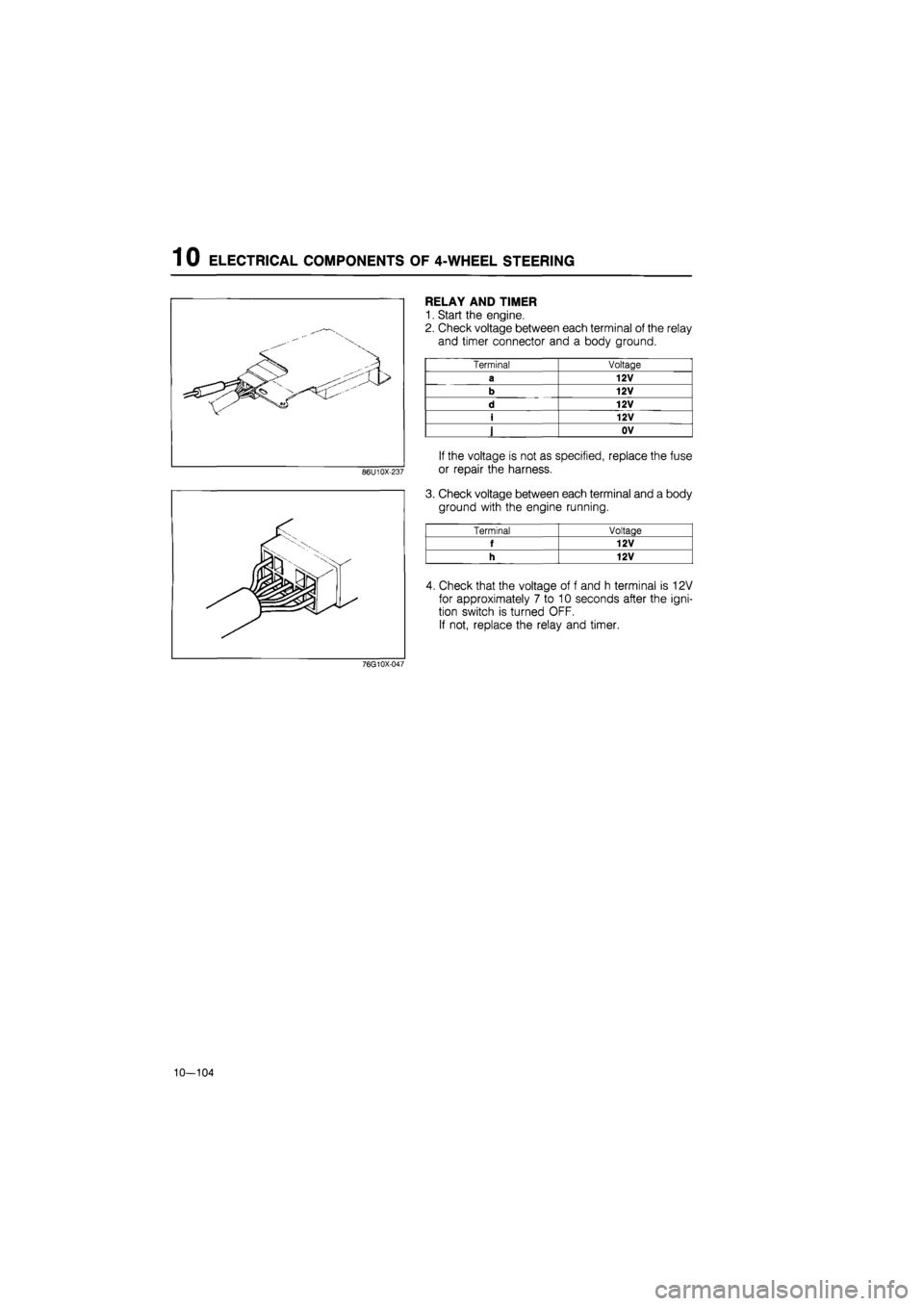
1 0 ELECTRICAL COMPONENTS OF 4-WHEEL STEERING
86U10X-237
76G10X-047
10—104
RELAY AND TIMER
1. Start the engine.
2. Check voltage between each terminal of the relay
and timer connector and a body ground.
Terminal Voltage
a 12V
b 12V
d 12V
i 12V
1 OV
If the voltage is not as specified, replace the fuse
or repair the harness.
3. Check voltage between each terminal and a body
ground with the engine running.
Terminal Voltage
f 12V
h 12V
4. Check that the voltage of f and h terminal is 12V
for approximately 7 to 10 seconds after the igni-
tion switch is turned OFF.
If not, replace the relay and timer.
Page 1393 of 1865
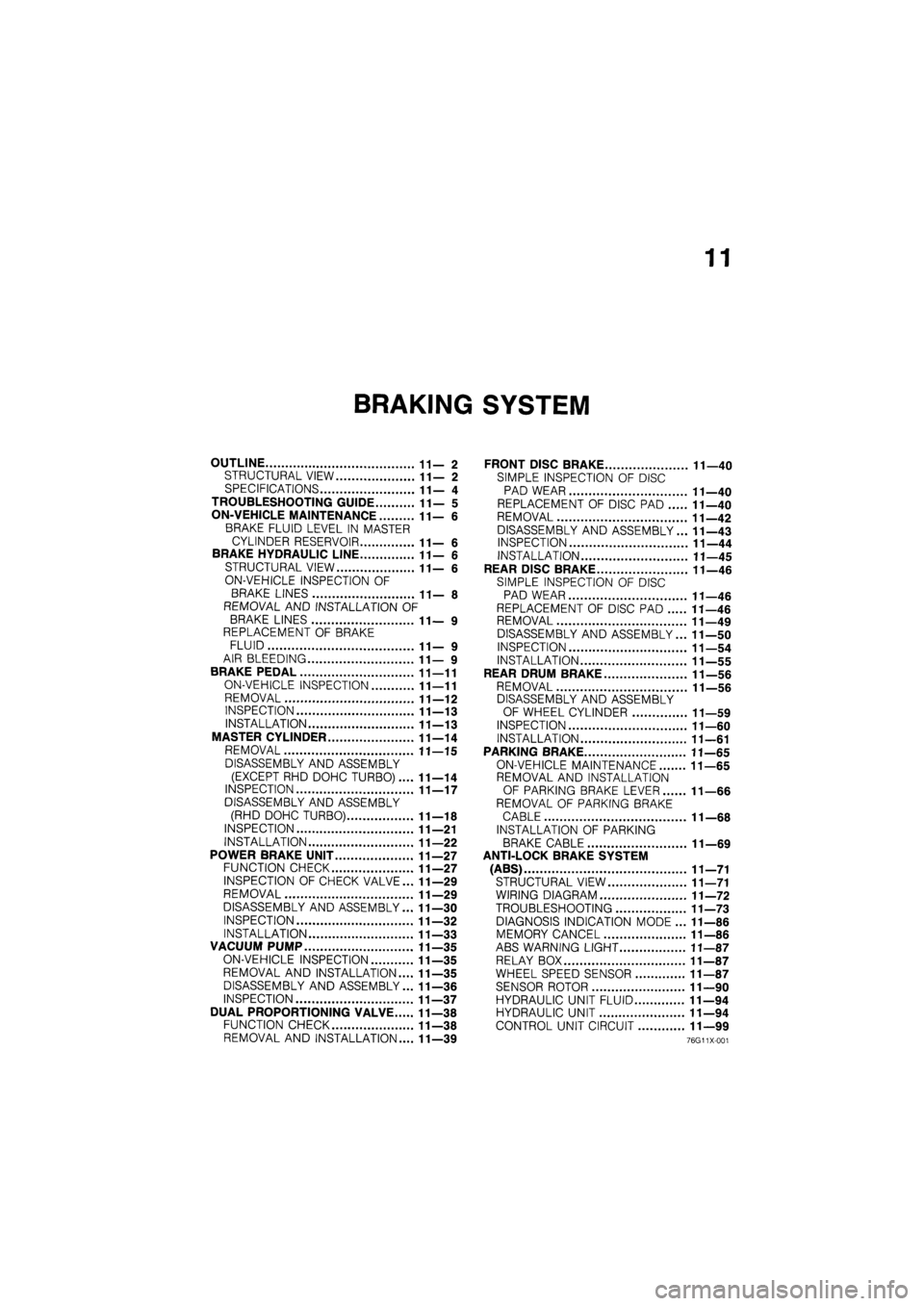
11
BRAKING SYSTEM
OUTLINE 11—2
STRUCTURAL VIEW 11—2
SPECIFICATIONS 11— 4
TROUBLESHOOTING GUIDE 11— 5
ON-VEHICLE MAINTENANCE 11—6
BRAKE FLUID LEVEL IN MASTER
CYLINDER RESERVOIR 11— 6
BRAKE HYDRAULIC LINE 11—6
STRUCTURAL VIEW 11—6
ON-VEHICLE INSPECTION OF
BRAKE LINES 11— 8
REMOVAL AND INSTALLATION OF
BRAKE LINES 11— 9
REPLACEMENT OF BRAKE
FLUID 11— 9
AIR BLEEDING 11— 9
BRAKE PEDAL 11—11
ON-VEHICLE INSPECTION 11—11
REMOVAL 11—12
INSPECTION 11—13
INSTALLATION 11—13
MASTER CYLINDER 11—14
REMOVAL 11—15
DISASSEMBLY AND ASSEMBLY
(EXCEPT RHD DOHC TURBO).... 11—14
INSPECTION 11—17
DISASSEMBLY AND ASSEMBLY
(RHD DOHC TURBO) 11—18
INSPECTION 11—21
INSTALLATION 11—22
POWER BRAKE UNIT 11—27
FUNCTION CHECK 11—27
INSPECTION OF CHECK VALVE... 11—29
REMOVAL 11—29
DISASSEMBLY AND ASSEMBLY... 11—30
INSPECTION 11—32
INSTALLATION 11—33
VACUUM PUMP 11—35
ON-VEHICLE INSPECTION 11—35
REMOVAL AND INSTALLATION.... 11—35
DISASSEMBLY AND ASSEMBLY... 11—36
INSPECTION 11—37
DUAL PROPORTIONING VALVE 11—38
FUNCTION CHECK 11—38
REMOVAL AND INSTALLATION.... 11—39
FRONT DISC BRAKE 11—40
SIMPLE INSPECTION OF DISC
PAD WEAR 11—40
REPLACEMENT OF DISC PAD 11—40
REMOVAL 11—42
DISASSEMBLY AND ASSEMBLY... 11—43
INSPECTION 11—44
INSTALLATION 11—45
REAR DISC BRAKE 11—46
SIMPLE INSPECTION OF DISC
PAD WEAR 11—46
REPLACEMENT OF DISC PAD 11—46
REMOVAL 11—49
DISASSEMBLY AND ASSEMBLY... 11—50
INSPECTION 11—54
INSTALLATION 11—55
REAR DRUM BRAKE 11—56
REMOVAL 11—56
DISASSEMBLY AND ASSEMBLY
OF WHEEL CYLINDER 11—59
INSPECTION 11—60
INSTALLATION 11—61
PARKING BRAKE 11—65
ON-VEHICLE MAINTENANCE 11—65
REMOVAL AND INSTALLATION
OF PARKING BRAKE LEVER 11—66
REMOVAL OF PARKING BRAKE
CABLE 11—68
INSTALLATION OF PARKING
BRAKE CABLE 11—69
ANTI-LOCK BRAKE SYSTEM
(ABS) 11—71
STRUCTURAL VIEW 11—71
WIRING DIAGRAM 11—72
TROUBLESHOOTING 11—73
DIAGNOSIS INDICATION MODE ... 11—86
MEMORY CANCEL 11—86
ABS WARNING LIGHT 11—87
RELAY BOX 11—87
WHEEL SPEED SENSOR 11—87
SENSOR ROTOR 11—90
HYDRAULIC UNIT FLUID 11—94
HYDRAULIC UNIT 11—94
CONTROL UNIT CIRCUIT 11—99
76G11X-001
Page 1394 of 1865
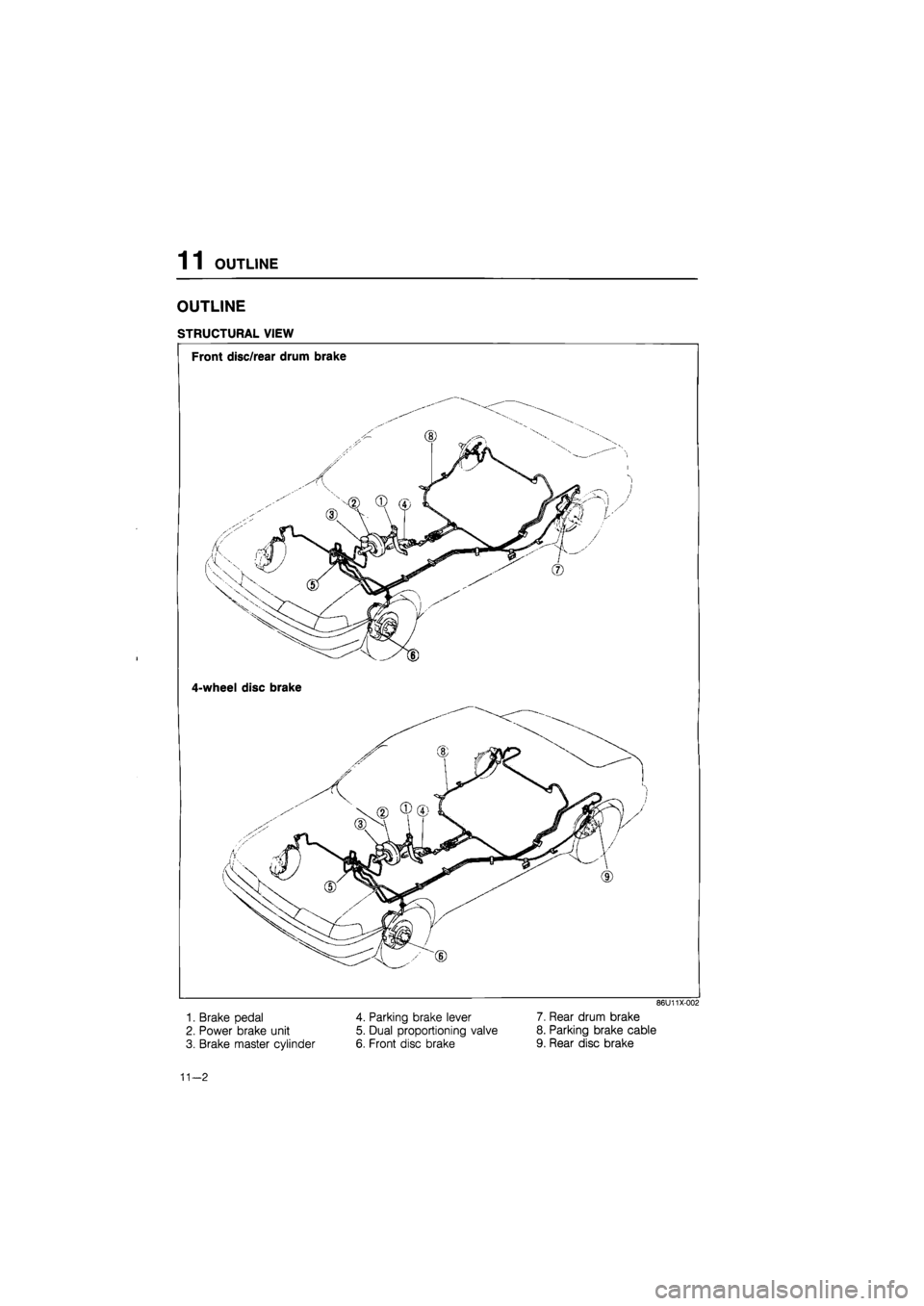
1 1 OUTLINE
OUTLINE
STRUCTURAL VIEW
i
Front disc/rear drum brake
4-wheel disc brake
1. Brake pedal
2. Power brake unit
3. Brake master cylinder
4. Parking brake lever
5. Dual proportioning valve
6. Front disc brake
86U11X-002
7. Rear drum brake
8. Parking brake cable
9. Rear disc brake
11—2
Page 1395 of 1865
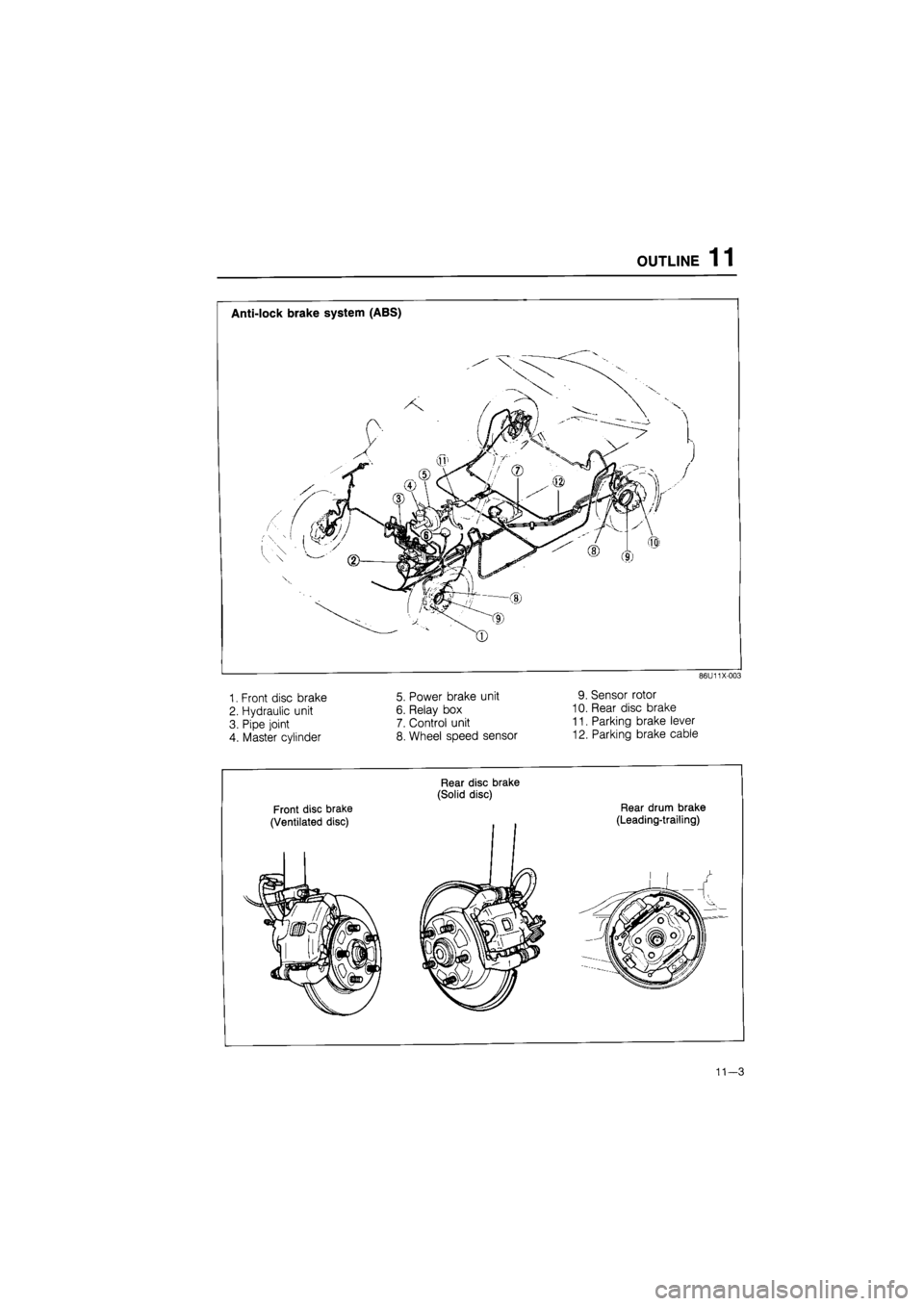
OUTLINE 11
86U11X-003
1. Front disc brake
2. Hydraulic unit
3. Pipe joint
4. Master cylinder
5. Power brake unit
6. Relay box
7. Control unit
8. Wheel speed sensor
9. Sensor rotor
10. Rear disc brake
11. Parking brake lever
12. Parking brake cable
Front disc brake
(Ventilated disc)
Rear disc brake
(Solid disc)
Rear drum brake
(Leading-trailing)
Page 1396 of 1865
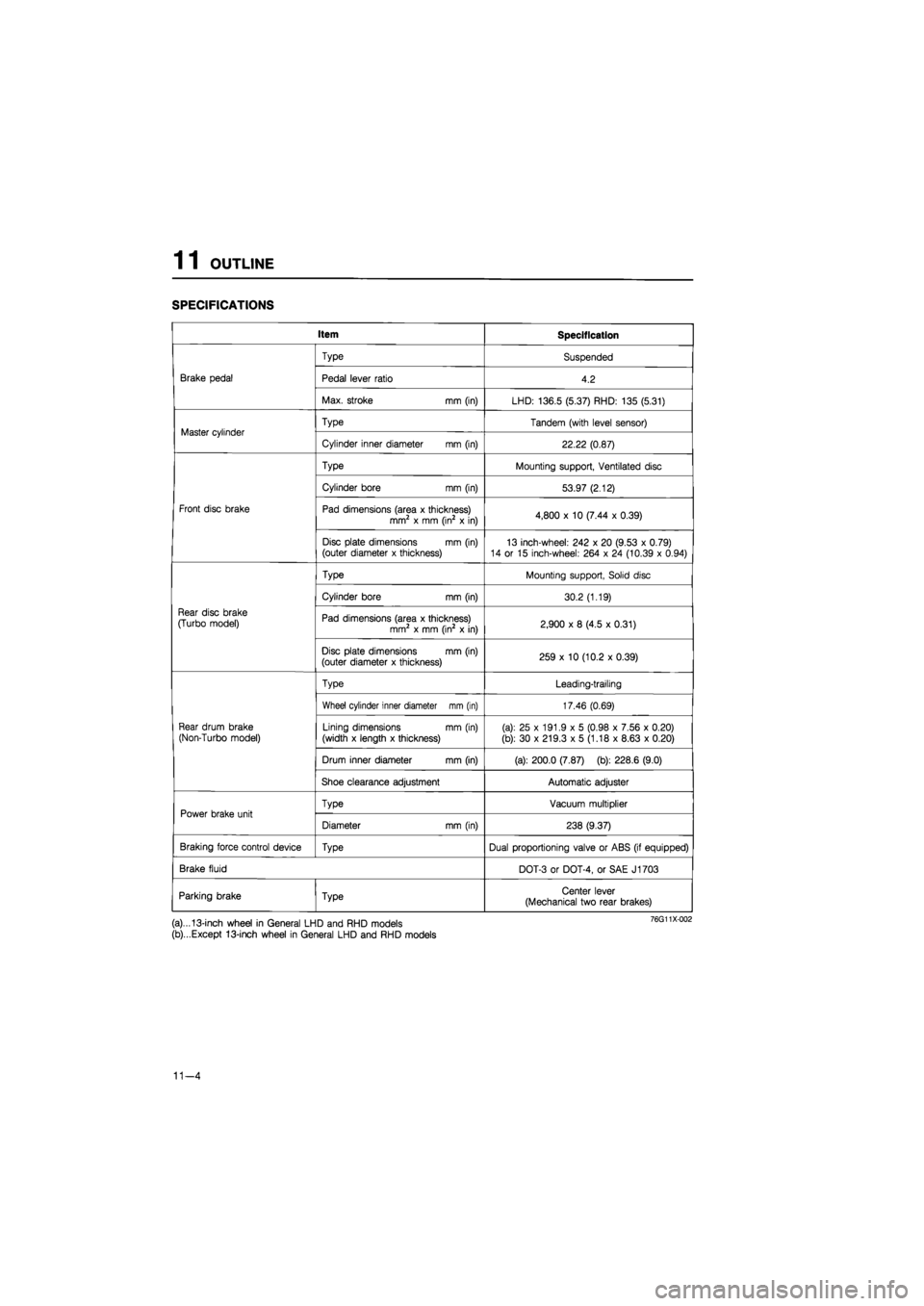
1 1 OUTLINE
SPECIFICATIONS
Item Specification
Brake pedal
Type Suspended
Brake pedal Pedal lever ratio 4.2 Brake pedal
Max. stroke mm (in) LHD: 136.5 (5.37) RHD: 135 (5.31)
Master cylinder Type Tandem (with level sensor) Master cylinder
Cylinder inner diameter mm (in) 22.22 (0.87)
Front disc brake
Type Mounting support, Ventilated disc
Front disc brake
Cylinder bore mm (in) 53.97 (2.12)
Front disc brake Pad dimensions (area x thickness) mm2 x mm (in2 x in) 4,800 x 10 (7.44 x 0.39) Front disc brake
Disc plate dimensions mm (in) (outer diameter x thickness) 13 inch-wheel: 242 x 20 (9.53 x 0.79) 14 or 15 inch-wheel: 264 x 24 (10.39 x 0.94)
Rear disc brake
(Turbo model)
Type Mounting support, Solid disc
Rear disc brake
(Turbo model)
Cylinder bore mm (in) 30.2 (1.19)
Rear disc brake
(Turbo model) Pad dimensions (area x thickness) mm2 x mm (in2 x in) 2,900 x 8 (4.5 x 0.31)
Rear disc brake
(Turbo model)
Disc plate dimensions mm (in) (outer diameter x thickness) 259 x 10 (10.2 x 0.39)
Rear drum brake
(Non-Turbo model)
Type Leading-trailing
Rear drum brake
(Non-Turbo model)
Wheel cylinder inner diameter mm (in) 17.46 (0.69)
Rear drum brake
(Non-Turbo model) Lining dimensions mm (in)
(width x length x thickness) (a): 25 x 191.9 x 5 (0.98 x 7.56 x 0.20)
(b): 30 x 219.3 x 5 (1.18 x 8.63 x 0.20)
Rear drum brake
(Non-Turbo model)
Drum inner diameter mm (in) (a): 200.0 (7.87) (b): 228.6 (9.0)
Rear drum brake
(Non-Turbo model)
Shoe clearance adjustment Automatic adjuster
Power brake unit Type Vacuum multiplier Power brake unit
Diameter mm (in) 238 (9.37)
Braking force control device Type Dual proportioning valve or ABS (if equipped)
Brake fluid DOT-3 or DOT-4, or SAE J1703
Parking brake Type Center lever (Mechanical two rear brakes)
(a)...13-inch wheel in General LHD and RHD models
(b)...Except 13-inch wheel in General LHD and RHD models
11-4
Page 1397 of 1865
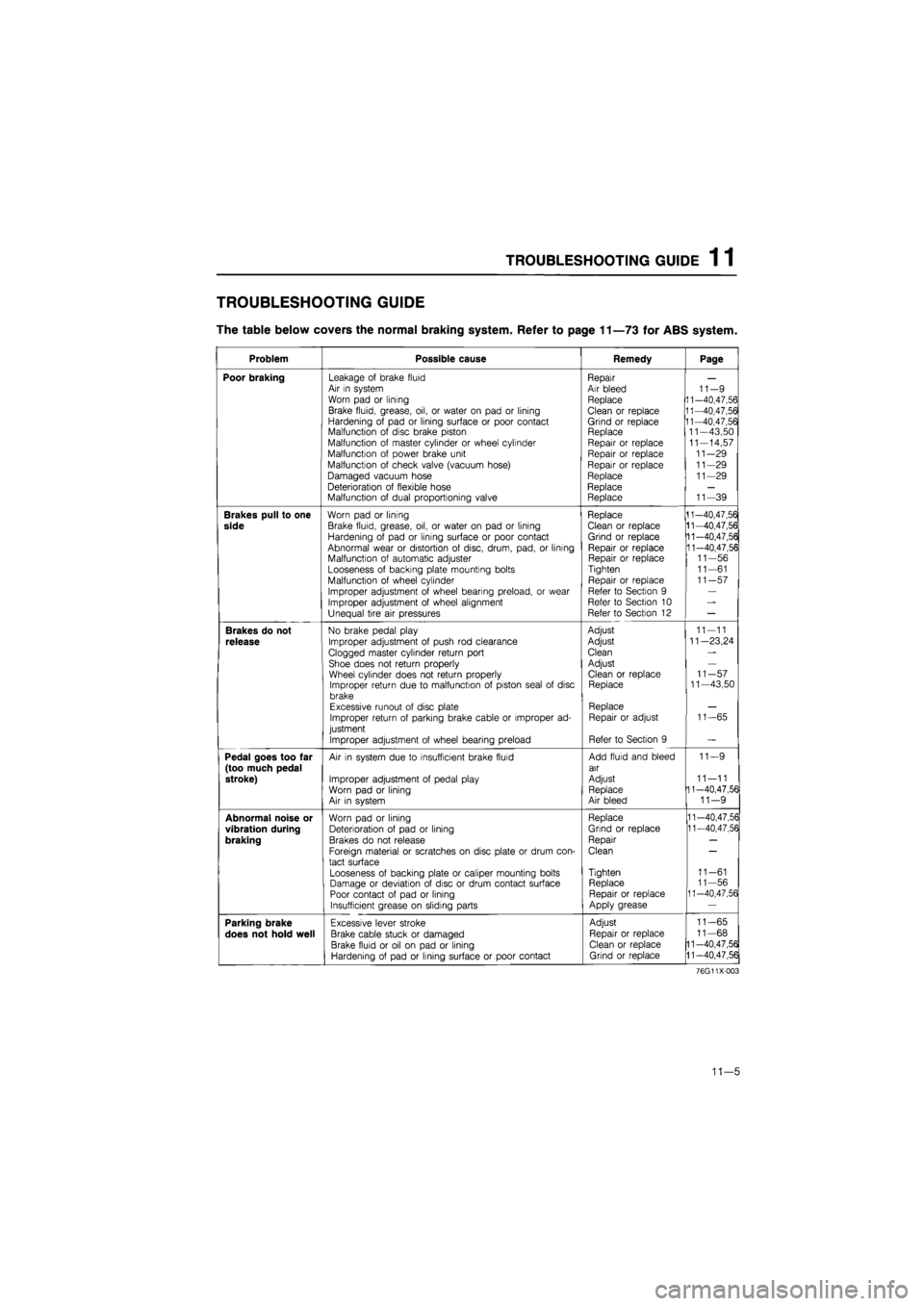
TROUBLESHOOTING GUIDE 1 1
TROUBLESHOOTING GUIDE
The table below covers the normal braking system. Refer to page 11—73 for ABS system.
Problem Possible cause Remedy Page
Poor braking Leakage of brake fluid Air in system Worn pad or lining
Brake fluid, grease, oil, or water on pad or lining Hardening of pad or lining surface or poor contact Malfunction of disc brake piston Malfunction of master cylinder or wheel cylinder Malfunction of power brake unit
Malfunction of check valve (vacuum hose)
Damaged vacuum hose Deterioration of flexible hose Malfunction of dual proportioning valve
Repair Air bleed Replace
Clean or replace Grind or replace Replace Repair or replace Repair or replace Repair or replace Replace Replace Replace
11-9 11-40,47,56 11-40,47,56 11-40,47,56 11—43,50 11-14,57 11-29 11-29 11-29
11-39
Brakes pull to one
side
Worn pad or lining
Brake fluid, grease, oil, or water on pad or lining Hardening of pad or lining surface or poor contact Abnormal wear or distortion of disc, drum, pad, or lining Malfunction of automatic adjuster Looseness of backing plate mounting bolts Malfunction of wheel cylinder
Improper adjustment of wheel bearing preload, or wear Improper adjustment of wheel alignment Unequal tire air pressures
Replace Clean or replace Grind or replace Repair or replace Repair or replace Tighten
Repair or replace Refer to Section 9 Refer to Section 10 Refer to Section 12
11-40,47,56 11-40,47,56 11-40,47,56 11-40,47,56 11-56 11-61 11-57
Brakes do not
release
No brake pedal play
Improper adjustment of push rod clearance
Clogged master cylinder return port Shoe does not return properly Wheel cylinder does not return properly Improper return due to malfunction of piston seal of disc brake Excessive runout of disc plate Improper return of parking brake cable or improper ad-justment
Improper adjustment of wheel bearing preload
Adjust
Adjust
Clean
Adjust Clean or replace Replace
Replace Repair or adjust
Refer to Section 9
11-11
11—23,24
11-57 11—43,50
11-65
Pedal goes too far (too much pedal stroke)
Air in system due to insufficient brake fluid
Improper adjustment of pedal play Worn pad or lining Air in system
Add fluid and bleed air
Adjust Replace Air bleed
11—9
11—11 11-40,47,56 11-9
Abnormal noise or
vibration during
braking
Worn pad or lining Deterioration of pad or lining Brakes do not release
Foreign material or scratches on disc plate or drum con-tact surface
Looseness of backing plate or caliper mounting bolts Damage or deviation of disc or drum contact surface Poor contact of pad or lining Insufficient grease on sliding parts
Replace
Grind or replace
Repair
Clean
Tighten Replace Repair or replace Apply grease
11-40,47,56 11-40,47,56
11-61 11-56 11-40,47,56
Parking brake
does not hold well
Excessive lever stroke
Brake cable stuck or damaged
Brake fluid or oil on pad or lining Hardening of pad or lining surface or poor contact
Adjust
Repair or replace Clean or replace Grind or replace
11-65
11-68
11-40,47,56
11-40,47,56
76G11X-003
11—5
Page 1401 of 1865

BRAKE HYDRAULIC LINE 1 1
REMOVAL AND INSTALLATION OF BRAKE
LINES
1. Loosen or tighten the flare nut with the SST.
Flare nut tightening torque: 13—22 N-m
(1.3—2.2 m-kg, 9—16 ft-lb)
2. When connecting the flexible hose, do not over-
tighten or twist it.
3. After installation:
(1) Check that the hose does not contact other
parts when the vehicle bounces or when the
steering wheel is turned all the way to the right
or left.
(2) Bleed the air from the brake system. (Refer to
page 11—9.)
REPLACEMENT OF BRAKE FLUID
1. Remove the brake fluid from the reservoir with a
suction pump.
2. Fill the reservoir with new, specified brake fluid.
3. Pump out the old brake fluid by loosening the
bleeder screws (one by one) and pumping the
brake pedal. (Refer to page 11—10 for details.)
AIR BLEEDING
Air Bleeding Locations
After the following parts are removed, air bleeding is necessary after installation.
Removed part
Air bleeding location
Removed part Front Rear Removed part
Right side Left side Right side Left side
Master cylinder * * * *
Wheel cylinder or caliper
Front Right side * — — —
Wheel cylinder or caliper
Front Left side — * — —
Wheel cylinder or caliper Rear disc Right side — — * — Wheel cylinder or caliper Rear disc Left side — — — * Wheel cylinder or caliper
Rear drum Right side — — * —
Wheel cylinder or caliper
Rear drum Left side — — — *
Dual proportioning valve * * * *
Hydraulic unit (ABS) * * * *
ABS: Anti-lock Brake System 76GHX-064 *: Indicates where air bleeding is necessary
11—9
Page 1432 of 1865
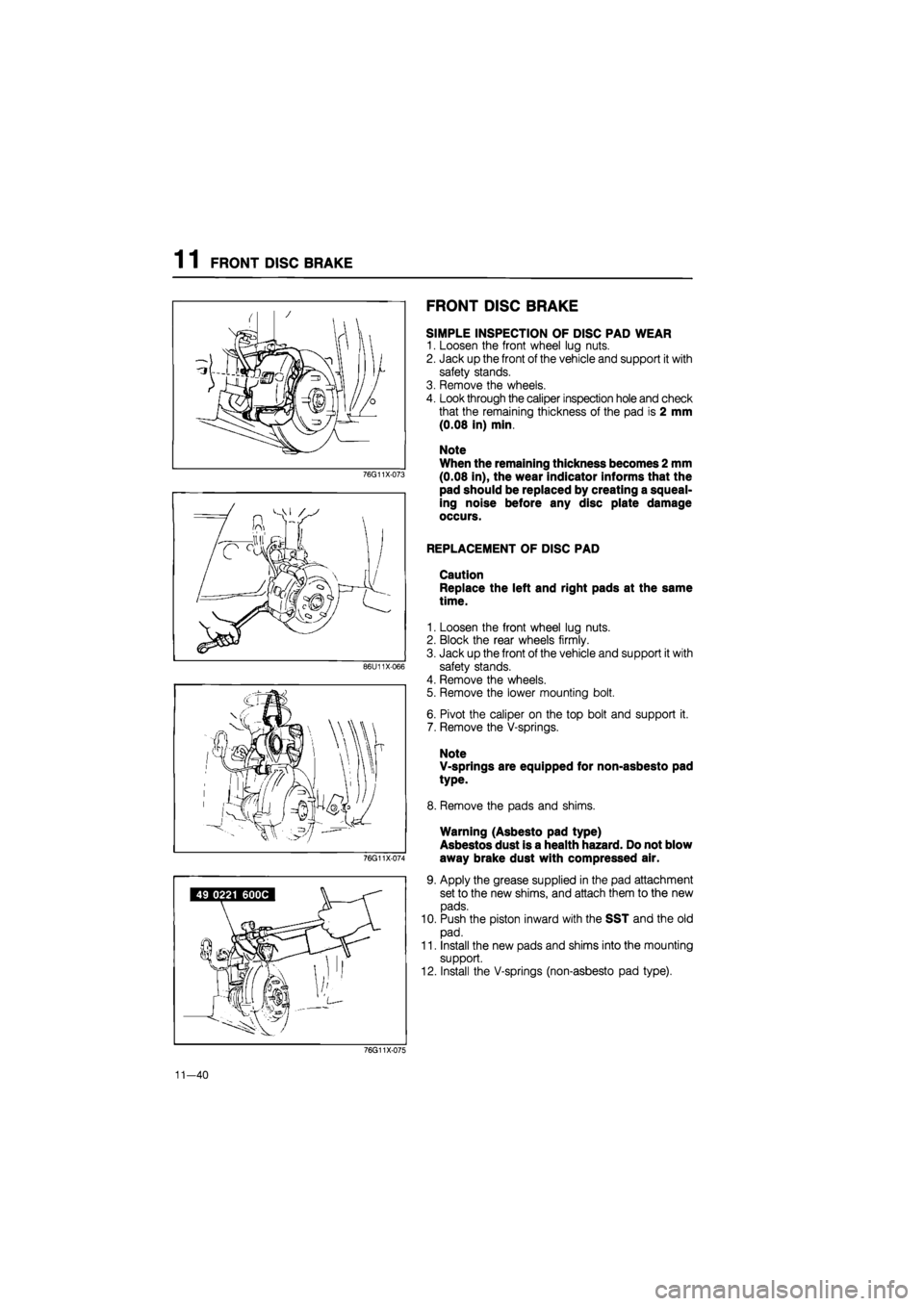
1 1 FRONT DISC BRAKE
76G11X-073
86U11X066
76G11X-074
FRONT DISC BRAKE
SIMPLE INSPECTION OF DISC PAD WEAR
1. Loosen the front wheel lug nuts.
2. Jack up the front of the vehicle and support it with
safety stands.
3. Remove the wheels.
4. Look through the caliper inspection hole and check
that the remaining thickness of the pad is 2 mm
(0.08 in) min.
Note
When the remaining thickness becomes 2 mm
(0.08 in), the wear indicator informs that the
pad should be replaced by creating a squeal-
ing noise before any disc plate damage
occurs.
REPLACEMENT OF DISC PAD
Caution
Replace the left and right pads at the same
time.
1. Loosen the front wheel lug nuts.
2. Block the rear wheels firmly.
3. Jack up the front of the vehicle and support it with
safety stands.
4. Remove the wheels.
5. Remove the lower mounting bolt.
6. Pivot the caliper on the top bolt and support it.
7. Remove the V-springs.
Note
V-springs are equipped for non-asbesto pad
type.
8. Remove the pads and shims.
Warning (Asbesto pad type)
Asbestos dust is a health hazard. Do not blow
away brake dust with compressed air.
9. Apply the grease supplied in the pad attachment
set to the new shims, and attach them to the new
pads.
10. Push the piston inward with the SST and the old
pad.
11. Install the new pads and shims into the mounting
support.
12. Install the V-springs (non-asbesto pad type).
76G11X-075
11-40